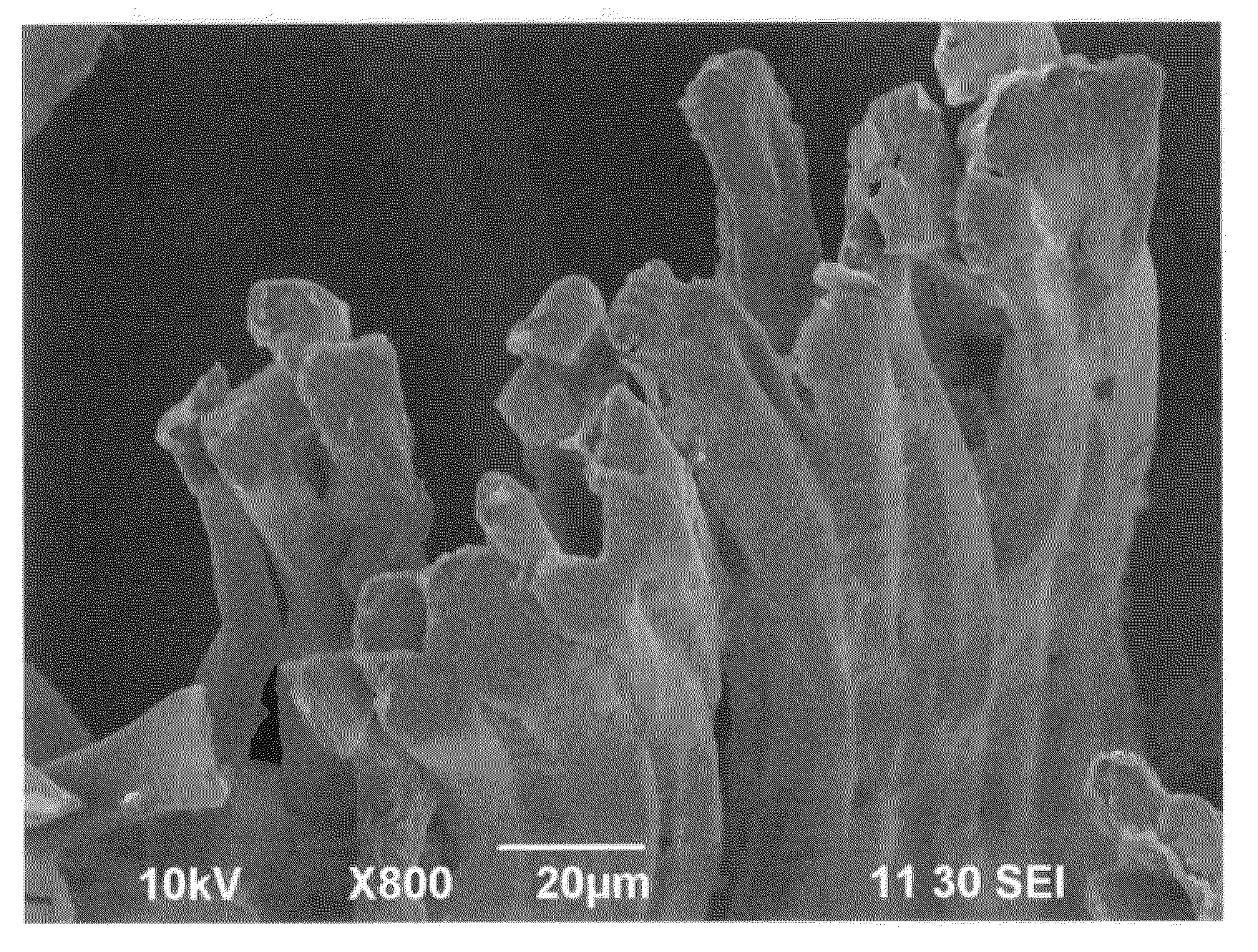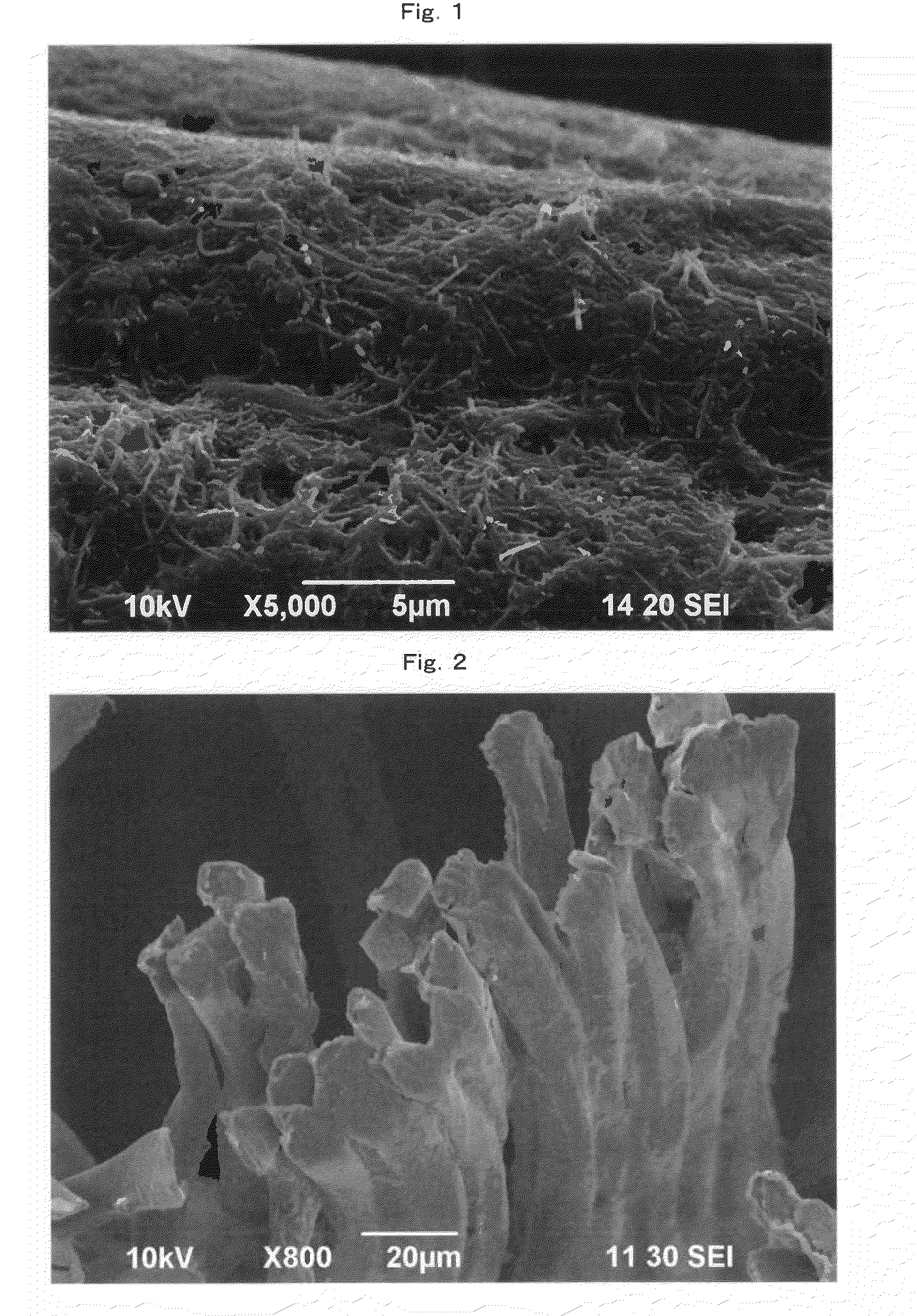Electro-conductive fibers with carbon nanotubes adhered thereto, electro-conductive yarn, fibers structural object, and production processes thereof
a technology of carbon nanotubes and electro-conductivity, which is applied in the direction of physical treatment, transportation and packaging, coatings, etc., can solve the problems of easy generation of static electricity (or electrostatic charges) by synthetic fiber products, damage to electronic devices, and spoilage of beauty, etc., to minimize the change (or increase) in mass, excellent electro-conductivity, and excellent electro-conductivity
- Summary
- Abstract
- Description
- Claims
- Application Information
AI Technical Summary
Benefits of technology
Problems solved by technology
Method used
Image
Examples
example 1
[0135](1) Preparation of Aqueous Carbon Nanotube Dispersion:
[0136](i) An aqueous solution of the surfactant (pH 6.5) was prepared by mixing 2.0 g of 3-(dimethylstearylammonio)propanesulfonate (a zwitterionic surfactant), 5 ml of glycerin (a hydration stabilizer), and 495 ml of deionized water.
[0137](ii) In a ball mill body (cylinder type, internal volume=1800 ml, ball diameter=150 mm, and filling amount of ball=3200 g), 500 ml of the aqueous solution of the surfactant obtained in the above step (i) and 15.2 g of carbon nanotubes (“MWCNT-7” manufactured by Nano Carbon Technologies Co., Ltd.) were put, and the mixture was stirred by hand to give a paste product. Then the ball mill body was placed on a rotating stand (“AS ONE” manufactured by ASAHI RIKA SEISAKUSYO, Co., Ltd.), and the paste product was stirred for one hour to give a liquid product containing the carbon nanotubes.
[0138](iii) The whole quantity of the liquid product containing the carbon nanotubes produced in the above s...
example 2
[0146](1) Preparation of Aqueous Carbon Nanotube Dispersion:
[0147](i) An aqueous solution of the surfactant (pH 6.5) was prepared by mixing 2.0 g of 3-(dimethylstearylammonio) propanesulfonate (a zwitterionic surfactant), 5 ml of glycerin (a hydration stabilizer), and 495 ml of deionized water.
[0148](ii) In a ball mill body (cylinder type, internal volume=1800 ml, ball diameter=150 mm, and filling amount of ball=3200 g), 500 ml of the aqueous solution of the surfactant obtained in the above step (i) and 30.4 g of carbon nanotubes (Baytube, manufactured by Bayer) were put, and the mixture was stirred by hand to give a paste product. Then the ball mill body was placed on a rotating stand (“AS ONE” manufactured by Asahi Rika Kenkyusho, Co., Ltd.), and the paste product was stirred for one hour to give a liquid product containing the carbon nanotubes.
[0149](iii) The whole quantity of the liquid product containing the carbon nanotubes produced in the above step (ii) was removed from the ...
example 3
[0156](1) Preparation of Aqueous Carbon Nanotube Dispersion:
[0157](i) An aqueous solution of the surfactant (pH 6.5) was prepared by mixing 2.0 g of 3-(dimethylstearylammonio)propanesulfonate (a zwitterionic surfactant), 5 ml of glycerin (a hydration stabilizer), and 495 ml of deionized water.
[0158](ii) In a ball mill body (cylinder type, internal volume=1800 ml, ball diameter=150 mm, and filling amount of ball=3200 g), 500 ml of the aqueous solution of the surfactant obtained in the above step (i) and 10.2 g of carbon nanotubes (“MWCNT-7” manufactured by Nano Carbon Technologies Co., Ltd.) were put, and the mixture was stirred by hand to give a paste product. Then the ball mill body was placed on a rotating stand (“AS ONE” manufactured by Asahi Rika Kenkyusho, Co., Ltd.), and the paste product was stirred for one hour to give a liquid product containing the carbon nanotubes.
[0159](iii) The whole quantity of the liquid product containing the carbon nanotubes produced in the above st...
PUM
| Property | Measurement | Unit |
|---|---|---|
| Temperature | aaaaa | aaaaa |
| Temperature | aaaaa | aaaaa |
| Fraction | aaaaa | aaaaa |
Abstract
Description
Claims
Application Information
 Login to View More
Login to View More - R&D
- Intellectual Property
- Life Sciences
- Materials
- Tech Scout
- Unparalleled Data Quality
- Higher Quality Content
- 60% Fewer Hallucinations
Browse by: Latest US Patents, China's latest patents, Technical Efficacy Thesaurus, Application Domain, Technology Topic, Popular Technical Reports.
© 2025 PatSnap. All rights reserved.Legal|Privacy policy|Modern Slavery Act Transparency Statement|Sitemap|About US| Contact US: help@patsnap.com


